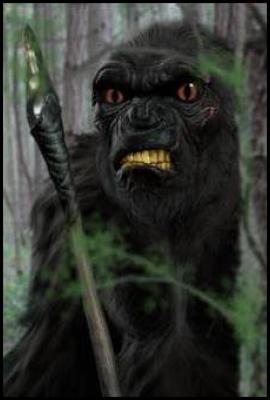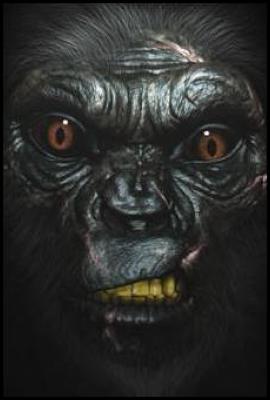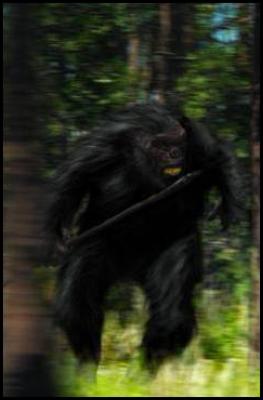Neanderthals Hunted, Raped And Ate Humans
Neanderthals Hunted, Raped And Ate Humans
Neanderthals were not the gentle, almost-human creatures portrayed in the media over the last 50 years. New Australian research reveals they were aggressive, powerful and terrifying carnivores—ruthless and efficient apex predators, who hunted, raped and ate early humans for over 50,000 years. The Neanderthal’s daily diet of nearly 2 kg of meat—the equivalent of 16 Quarter Pounders—included human flesh.

Click to enlarge
Based on the research, Australian independent scholar Danny Vendramini has developed “Neanderthal predation theory”, which argues that the evolution of modern humans—including our unique physiology, sexuality and human nature—is the result of a reaction to this systematic long-term sexual predation and cannibalism by Eurasian Neanderthals.

Click to enlarge
Vendramini’s forthcoming book Them and Us: how Neanderthal predation created modern humans, describes how the human population of the Mediterranean Levant—the population from which every human on earth is descended—was almost wiped out by Neanderthal predation, until there were only 50 human individuals left in the region. He illustrates how those 50 survivors salvaged humankind from annihilation by transforming into aggressive and predatory beings that fought back—spreading across the globe, killing (and sometimes eating) all Neanderthals in their path, as well as ‘Neanderthal-looking’ hominids, until Neanderthals themselves became extinct.
Vendramini describes this global migration through Europe, Africa, Asia and Australia and the Americas, as “a 20,000 kilometre blitzkrieg”. It did not end until these hyper-aggressive humans—our ancestors the Cro Magnons—were the only hominids left alive. “It was the first instance of evolution by genocide”, he says.

Click to enlarge
In partnership with Madrid-based digital sculptor Arturo Balseiro, Vendramini presents blood-curdling computer generated images (below) of what Neanderthals really looked like—based on 3D scans of Neanderthal skulls and bones.
“Not only have we had the wrong impression of the nature and behaviour of Neanderthals”, argues Vendramini, “but we have been fed sentimental, anthropomorphic visuals of them as well. Neanderthals”, he says, “were primates and would have looked like primates. There is no reason to suppose they were clean-shaven with protruding noses and curly hair. These guys”, he expounds, “came from the frozen north—they had flat, ape-like noses, large nocturnal eyes, were covered in thick hair and were six times stronger than the average human. They were not a pretty sight.”
Leading authority on Neanderthals, Professor John Shea of Stony Brook University in New York, is enthusiastic about Neanderthal predation theory: “Danny Vendramini presents a truly unique and innovative picture of the role of Neanderthal predation in human evolution.
“He pulls together countless different threads of scientific evidence to re-cast Neanderthals as ‘apex predators’, proverbial ‘wolves with knives’ who were effective rivals with our ancestors.
“His thesis,” continues Shea, “that many physical, social, and psychological characteristics now seen as uniquely human are direct results of Neanderthal predation on our ancestors will be sure to ignite controversy in scientific meetings, university classrooms, and among any group of people genuinely interested in human evolution.”
ENDS


 New Zealand Catholic Bishops Conference: Cardinal Dew Leaves For Pope's Funeral, Papal Election
New Zealand Catholic Bishops Conference: Cardinal Dew Leaves For Pope's Funeral, Papal Election The Nature Conservancy: Bird Species Lost From Wild For Almost 40 Years Lays First Eggs On New Island Home
The Nature Conservancy: Bird Species Lost From Wild For Almost 40 Years Lays First Eggs On New Island Home PAN Asia Pacific: On Earth Day, A New Report Reveals Safer Pest Management Options Beyond Chlorpyrifos
PAN Asia Pacific: On Earth Day, A New Report Reveals Safer Pest Management Options Beyond Chlorpyrifos UNODC: Cyberfraud in the Mekong reaches inflection point
UNODC: Cyberfraud in the Mekong reaches inflection point Gary M. Feinman, IMI: Archaeology Can Now Tell Us How People Have Muffled And Challenged Economic Inequality Across History
Gary M. Feinman, IMI: Archaeology Can Now Tell Us How People Have Muffled And Challenged Economic Inequality Across History CNS: Will All Children Be Born Free Of HIV, Syphilis And Hepatitis-B By 2030?
CNS: Will All Children Be Born Free Of HIV, Syphilis And Hepatitis-B By 2030?